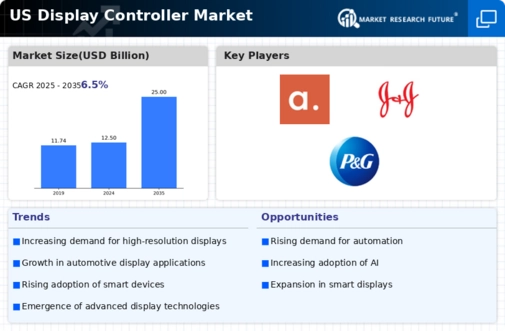Advancements in Automotive Displays
The automotive sector is undergoing a transformation, with an increasing emphasis on advanced display technologies. The display controller market is poised to benefit from the integration of high-resolution displays in vehicles, enhancing user experience and safety. By 2025, the automotive display market is expected to surpass $30 billion, with a significant portion attributed to infotainment systems and digital dashboards. As automakers strive to incorporate larger and more interactive displays, the demand for sophisticated display controllers rises. These controllers must support various functionalities, including touch input and connectivity with mobile devices. The display controller market must keep pace with these advancements, ensuring that products meet the stringent requirements of automotive applications. This trend indicates a promising avenue for growth, as the automotive industry increasingly prioritizes technology and user-centric design.
Emergence of Smart Home Technologies
The rise of smart home technologies is reshaping the display controller market, as consumers increasingly seek integrated solutions for home automation. Smart displays serve as central hubs for controlling various devices, necessitating advanced display controllers that can manage multiple inputs and outputs. By 2025, the smart home market is anticipated to exceed $150 billion, with a significant focus on display technologies. This trend indicates a growing demand for display controllers that support voice recognition, touch interfaces, and connectivity with IoT devices. The display controller market must adapt to these evolving requirements, ensuring that products are compatible with a wide range of smart home ecosystems. As consumers prioritize convenience and connectivity, the potential for growth in the display controller market appears substantial.
Surge in Consumer Electronics Demand
The display controller market experiences a notable surge in demand driven by the increasing consumer electronics sector in the US. As households adopt smart TVs, gaming consoles, and high-definition monitors, the need for advanced display controllers becomes paramount. In 2025, the consumer electronics market is projected to reach approximately $400 billion, with a significant portion allocated to display technologies. This growth indicates a robust opportunity for manufacturers to innovate and enhance their product offerings. The display controller market must adapt to these evolving consumer preferences, ensuring compatibility with various devices and resolutions. Furthermore, the rise of 8K and 4K displays necessitates sophisticated display controllers capable of handling higher data rates and improved image quality. This trend suggests that companies focusing on consumer electronics will likely drive substantial growth in the display controller market.
Growth of Augmented and Virtual Reality
The display controller market is significantly influenced by the rapid growth of augmented reality (AR) and virtual reality (VR) applications. As industries such as gaming, education, and healthcare adopt AR and VR technologies, the demand for high-performance display controllers escalates. In 2025, the AR and VR market is projected to reach $200 billion, with a substantial portion dedicated to display technologies. This growth necessitates the development of display controllers that can handle high refresh rates and low latency, ensuring a seamless user experience. The display controller market must innovate to meet these demands, potentially leading to breakthroughs in performance and functionality. Furthermore, as AR and VR applications become more mainstream, the need for versatile display controllers that can adapt to various use cases will likely drive further expansion in the market.
Increased Focus on High-Performance Gaming
The gaming industry is witnessing a remarkable transformation, with an increased focus on high-performance gaming experiences. The display controller market is directly impacted by this trend, as gamers demand higher resolutions, faster refresh rates, and enhanced graphics. In 2025, the gaming market is projected to reach $200 billion, with a significant portion dedicated to gaming hardware, including display technologies. This growth necessitates the development of advanced display controllers capable of delivering superior performance and responsiveness. The display controller market must innovate to meet the expectations of gamers, who seek immersive experiences and seamless gameplay. As competitive gaming continues to rise, the demand for high-quality display controllers is likely to increase, presenting a promising opportunity for manufacturers to capture market share.













Leave a Comment